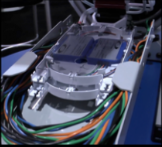As I travel the country working with customers large and small, one of the challenges I see repeated among all of them is that of “squeezing” more capacity from their outside plant facilities. While most are aware that they can use CWDM or DWDM to increase the capacity of fiber itself, they may find that current support structure such as closures or housings do not have room for the WDM device. So, what started out as a simple deployment of a passive device, quite often becomes a job that involves placement of a new closure or other infrastructure, along with the splicing and other craft work that then becomes necessary.
Earlier this year, our Vice-President of Product Development, Dave Braga, wrote a blog article that addresses this issue. With his permission, I have quoted from it generously to explain how a vendor can help a service provider address this challenge.
Often, an important consideration when increasing the capacity of a fiber network is how well any new equipment will mesh with existing infrastructure.

This is true not only of the fiber and optical components, but also of any of the supportive structure that must interact with them such as splice trays, housings, closures, etc. The most successful deployments are often those that effectively “bridge the gap” between old and new technologies.
As increasing bandwidth demand continues to drive network growth, it is imperative that service providers are able to exploit their deployed fiber assets. Necessary for this is the assurance that new passives and other peripherals can readily fit into the current network. Backward compatibility allows newer technologies to advance without superseding current network elements. Properly designed fiber products take into consideration factors such as existing hardware, industry standards, network company operations, space availability and much more. These challenges can be intimidating and sometimes the only answer would seem to be replacement of existing equipment with a whole new “system” of equipment, housings and other peripherals. To help justify this approach economically, such a solution is often suggested to be “future-ready.” Instead, it might make sense that the provider look to an approach that is backward compatible with their current hardware and network architecture.
Indeed, a more prudent approach may be to use products designed to successfully move a network provider and its end-users into the future, while taking advantage of already-deployed assets. New devices, smartly designed to work within these already defined network boundaries provide the simplest and lowest cost approach to providing new service revenues.
This is the philosophy used by my own company when designing passive optical components as well as how they integrate into existing and new networks.
Consider, for example, a service provider looking to relieve at-capacity fibers using WDM. Placement of the WDM components in appropriate closures must be considered, whether in the outside plant, on the customer’s premises, or both. Often, closures have already reached capacity through a lack of adequate cable ports or availability of space on a splice tray. In such a case, a typical solution would call for deployment of a new closure to house new WDM components.
To answer this network challenge, what if we could combine a compact modularly designed passive, an accompanying splice tray built to fit in an unused portion of the already-deployed closure, and an adapter that allows the tray to mimic the existing trays? (see photo)
In this way the time and expense of a second closure can be avoided. Such an approach:
- Exploits the current network infrastructure model
- Creates greater customer satisfaction
- Accelerates the revenue model
- Minimizes construction and deployment costs
Essentially, careful design of new components to fit into current infrastructure elements increases the scalability of the network. Contrast this with the costs of beginning the transformation to a network design that requires new passives, new closures, new housings, etc. Such a comparison should make it readily clear that network components specifically designed to fit into current ecosystems are the intelligent decision.